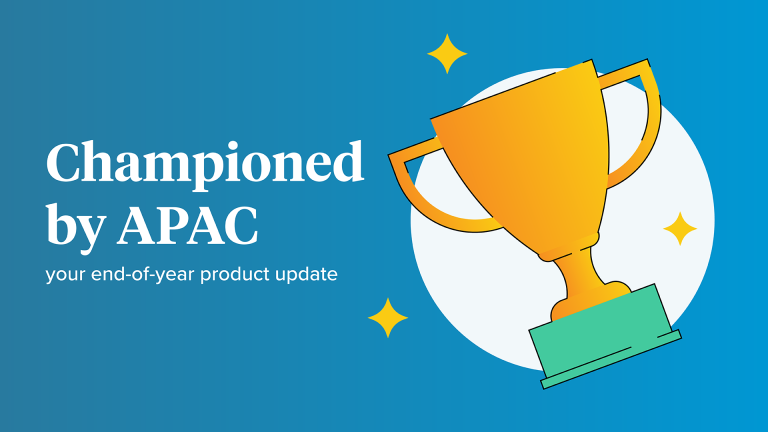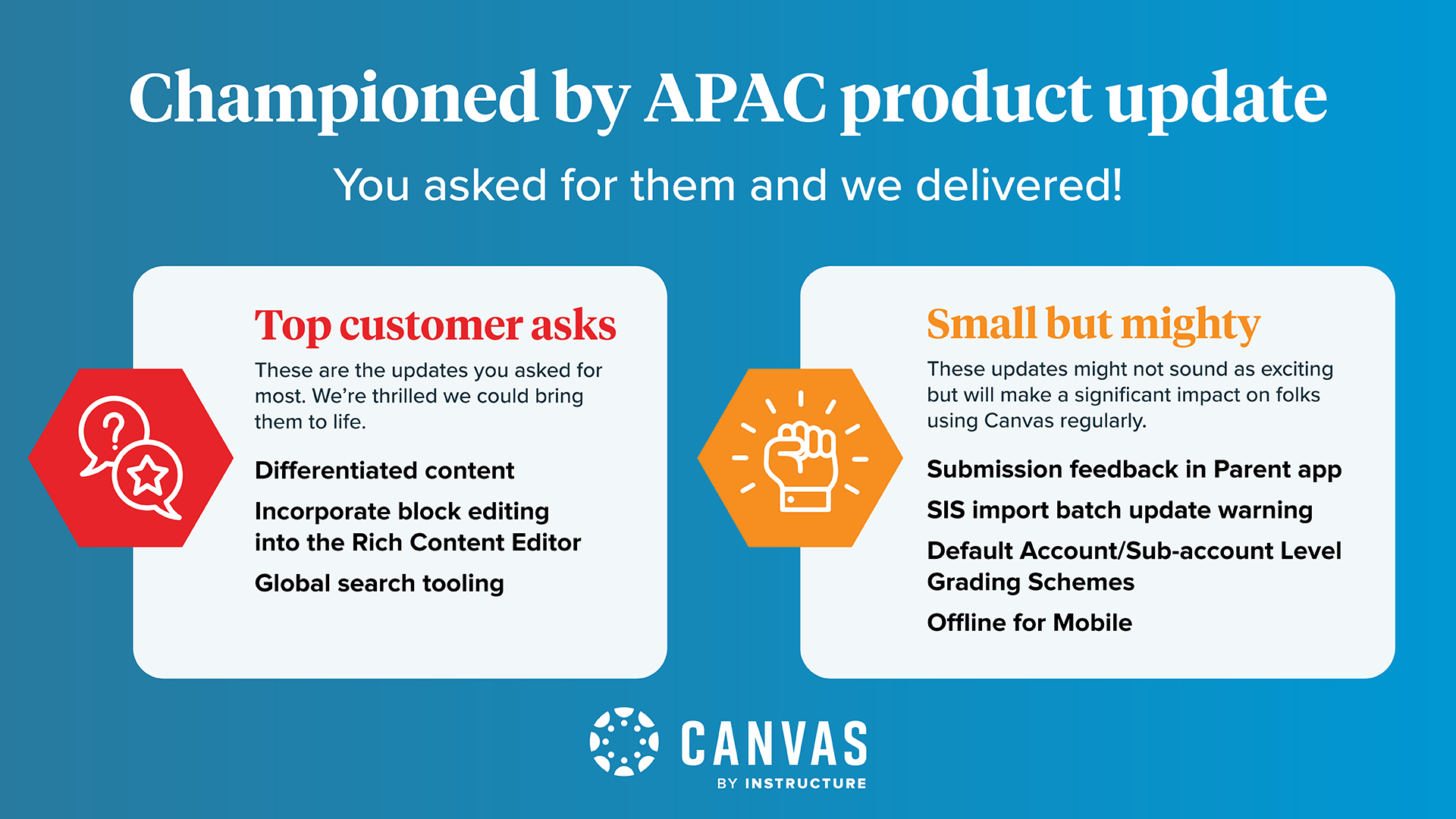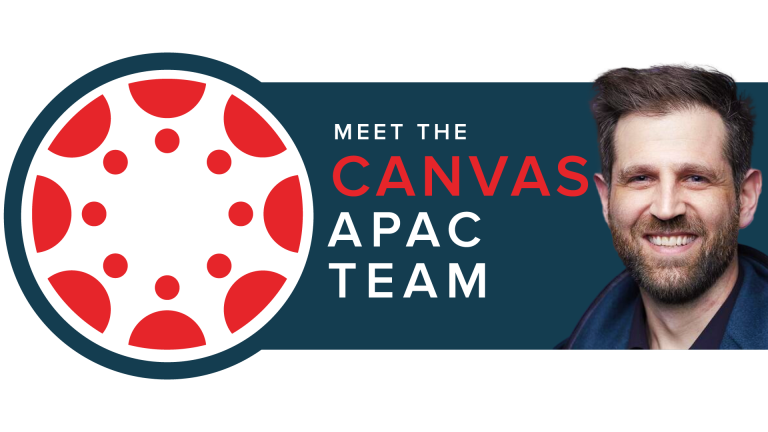
Can you believe we're already wrapping up 2024? What a year it's been for Canvas!
We've rolled out some big releases like Intelligent Insights, complete with an AI-powered analytics solution, and even snuck in a few handy features you might've missed, like offline mode in the Student App. But here's the really great part—many of this year's updates and improvements came straight from you, our awesome APAC customers.
You've been the real MVPs, pushing us to make things better. We know it's easy to lose track of all the changes when you're busy, so we've put together a list of updates you might've missed. There's some good stuff in here that we're pretty excited about, and we think you will be, too.
Top customer asks
In APAC, these were some of the most-asked-for updates and we delivered. Take a bow, you’ve earnt it.
Differentiated content
What it is:
This feature allows teachers or course builders to selectively release content, leveraging the simple and intuitive “Assign to” workflow users know and love.
In addition to communication and assessment artefacts, which you could already selectively allocate, users can now differentiate individual pages or whole modules of content based on the unique needs of Sections and/or individual students within a course. This helps create a more flexible and comprehensive teaching and learning experience for all.
Why it matters:
We wanted to give teachers and course managers the power to manage allocation of all course content in a robust, straightforward way.
Now, learners see only what’s relevant to them at any given time, unlocking a more personalised and meaningful experience. Differentiated content also enables teachers to seamlessly manage a host of differentiation use cases, all within a single Canvas course: think multimodal course deliveries (for example, some students may need slightly different versions of the content if they are online only vs on campus), electives, individual learning requirements, or accommodations.
This will be particularly powerful for our VET customers, as differentiated content offers a painless method for organising validated content, managing continuous improvement of training and assessment materials, and catering for rolling enrolment cohorts.
Most importantly, this feature has been a top ask from our ANZ higher education, K12, and VET user groups for many years. There were countless institutions directly involved throughout discovery, design validation, and feedback to ensure we delivered a capability which was aligned to your needs. We are thrilled to have delivered this in July.
Incorporate block editing into the Rich Content Editor
What it is:
Currently in closed beta, Block Editor introduces a simplified drag-and-drop editor interface to make it easy for teachers and course designers to create beautiful, accessible course content that is responsive to device type or screen size.
This feature, free as part of your Canvas LMS subscription, will be an alternative editing experience—it won’t replace the traditional Rich Content Editor, but rather gives users the utmost flexibility for page content creation.
We’re also aware that you may not always be building content on the same device type that your learners will be consuming it, so we’re including a new preview capability to see how your content looks on desktop, tablet, and mobile before publishing.
Why it matters:
Not everyone is a content designer—or has access to one!—and not everyone has experience with HTML. So we’re removing these barriers and introducing a content creation workflow designed to serve all users. The Block Editor will unlock accessible and engaging content building that is achieved quickly regardless of your design expertise, while still offering the HTML capability for those craving more.
There’ll also be no more overwhelming blank Canvas’ (excuse the pun), as the new editing experience offers content scaffolding to help get you started. Customers across the APAC region have requested a native tool to help support simple drag and drop content elements including all your favourite staples, like tabs, quiz questions, galleries and many more. We’re excited to be releasing this for all customers in the coming months.
Global search tooling
What it is:
Leveraging semantic algorithms and AI, Smart Search allows users to search Canvas course content by understanding the context of queries and finding relevant results based on that context, facilitating faster content discovery for both teachers and students.
Why it matters:
A simple search tool that takes the guesswork out of locating relevant course materials has been a top request from our customer community here in APAC, as well as more broadly around the world, for some time.
We recognise that students often know they’ve covered a particular topic throughout their course, but they can’t remember which exact Module or in which week that happened, or a teacher may be on the hunt for a particular content page or assignment in a sea of resources.
Smart Search enables them to swiftly find what they’re looking for, getting them back to teaching, learning, or revising quicker. We are really excited to have unlocked an important use case for our customers by leveraging AI in a meaningful way.

Small but mighty—not to be missed
These are the updates that may seem simple or less flashy than the ones above, but will make a significant impact on your day-to-day activities within Canvas.
Submission feedback in Parent app
What it is:
Observers, typically parents/carers/guardians, can now view assignment submission content and feedback in the Assignment Details page of the Canvas Parent App. Feedback visibility includes the submissions rubric, comments, and annotations.
Why it matters:
Lack of visibility for submission feedback has been one of the most pressing challenges for our K12 customers small and large, and we fully understand why.
In most school settings across Australia and New Zealand, submission feedback is far more important, and holds more value for parents/carers/guardians, than simply the numeric or letter mark the learner received.
These users want to know the why behind the mark that’s been awarded, and what advice or guidance the teacher has provided their child for subsequent submissions. We know many schools have relied on other tools and custom portals to surface this information, and we’re thrilled to now support this natively in the Canvas Parent App.
SIS import batch update warning
What it is:
On the Account-level SIS import page, we’ve introduced a warning message which informs users of the risks associated with selecting the ‘This is a full batch update’ checkbox. Additionally, a confirmation modal appears when initiating data processing.
Why it matters:
This additional warning may seem over-cautious. However, many customers, especially our smaller institutions who rely fully on manual SIS import processes, have flagged the risk of user error with this setting during the import workflow and requested we call these out more plainly.
This update helps prevent accidental or unintended SIS import actions that could have significant ramifications across an account.
Admin Manage Access tokens
What it is:
Admins can now limit the generation of access tokens with the Admin Manage Access token feature option, limiting personal access token creation to admins account setting and the Users-Manage Access Token admin permission.
Why it matters:
This enhancement allows institutions to restrict users from being able to create user access tokens and either manage it on a by-request basis as admins or create a new account role that has the permission to create user tokens.
This is huge for our large customers in particular who have been craving more granular, flexible mechanisms for managing access tokens in Canvas LMS. This will also promote improved security by helping prevent potential misuse or security breaches.
Default Account/Sub-account Level Grading Schemes
What it is:
We’ve introduced a new management capability for Canvas LMS administrators, allowing them to nominate an account or sub-account level default grading scheme, offering enhanced institutional consistency and personalisation.
Why it matters:
Another feature borne from APAC feedback, there's been a desire to select an institutional grading scheme as the default, at both the account and subaccount levels of an instance—and we have delivered just that!
Our customers often need schemes that differ from the default Canvas option. Customisation of this offers better alignment of institutional grading with pedagogical needs, and reduces the administrative burden of selecting and auditing their use.
Admins can now override the Canvas default grading scheme with their chosen scheme, creating efficiency, flexibility, and peace of mind.
Offline for Mobile
What it is:
In January this year, we released offline support for the Canvas Student App, allowing students to access the app and use its core functions at any time, regardless of their internet connection.
Institutions that choose to use this feature will give students the opportunity to download certain parts of their courses and access that content through the app, offering personalised synchronisation options for their content.
Why it matters:
Though we already offer offline access via desktop devices, we know many learners interact with Canvas exclusively via the app. Previously, the Canvas mobile apps required an internet connection to leverage them.
While this need was championed by our users in the Philippines, the use cases resonate with learners all over the world: those without internet at home, those commuting to school or class, those living in regional or remote areas, institutions without consistent internet services—it benefits so many!
Introducing this capability enables students to engage in learning without boundaries through a seamless, intuitive, and secure offline mode, unlocking the power to consume learning, regardless of where you are or the resources at your disposal, so that no learner is left behind.
Final thoughts
As we approach the end of 2024, I want to extend a heartfelt thank you to each of you. Your feedback and questions are invaluable—they inspire us to improve not just for you, but for institutions across the region and around the world. It's your input that drives Canvas to evolve and remain the standout LMS it is today.
We always welcome your suggestions. Feel free to reach out to your CSM, connect with your user group, or get involved with the Canvas Community, now 2 million members strong. I look forward to seeing what we'll accomplish together in 2025!
Related Content
 philippines_ched_cmo.png
philippines_ched_cmo.pngBlogs
 meet-canvas-apac-team-avi.png
meet-canvas-apac-team-avi.pngBlogs
 mom_and_baby_with_laptop_2.jpg
mom_and_baby_with_laptop_2.jpgBlogs
